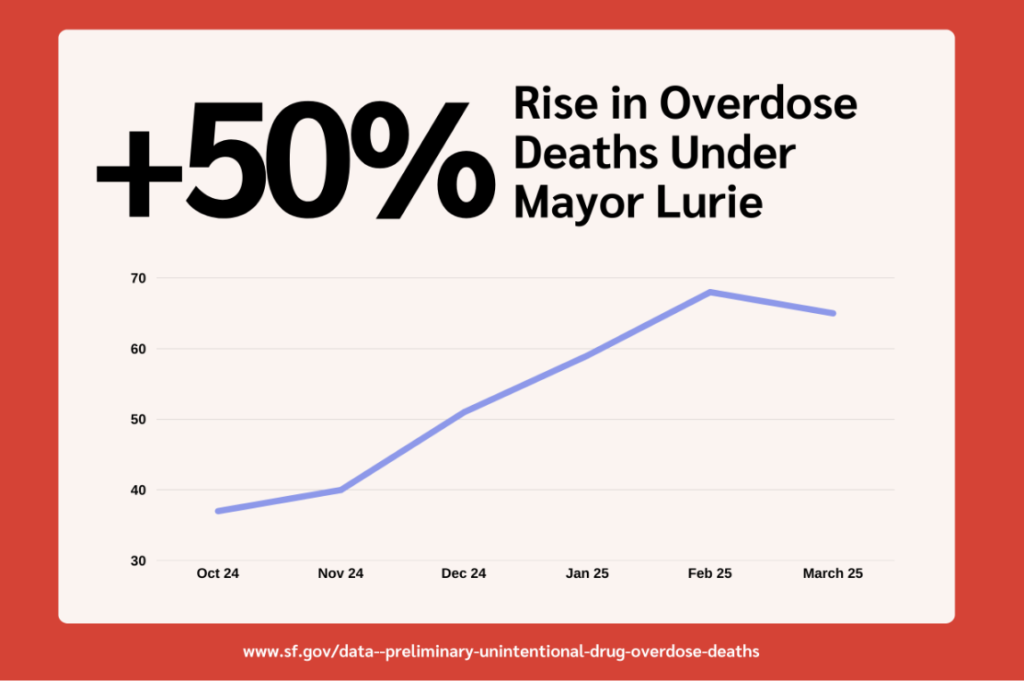Imagine if Chesa Boudin were still the district attorney, and progressives controlled the Board of Supes—and fentanyl deaths had gone up 50 percent in just three months.
This would be front-page news in the Chron. It would lead all the TV stations evening news shows. The tough-on-crime folks would be fuming, denouncing “failed policies” and demanding new leadership.
But since Mayor Daniel Lurie took office with a conservative board, cracked down hard on public drug sales and use, packed the jails, and jammed the courts, fentanyl deaths are up 50 percent, according to city data.

Hardly anyone in the news media is talking about it—and the mayor and the DA and the pro-police supes are taking no criticism at all.
From former Sup. Dean Preston:
If you look past the press releases and corporate media headlines, you’ll see that what’s actually happening is people in active addiction are being shuffled from one block to another, arrested, jailed, and released, in a revolving door that does nothing to reduce drug use or prevent deaths. Meanwhile, science-backed approaches like overdose prevention centers, supportive housing, and expanded access to treatment are being sidelined.
A study in the Harm Reduction Journal, looking specifically at San Francisco, concluded that
the traditional policing approach to drug use-related crime did not reduce arrests or incarceration and was associated with a risk of future overdose fatalities.
That makes perfect intuitive sense: Just look at what’s going on in the jails. People going through withdrawal are locked up; people with mental health issues are behind bars without treatment. There are outbreaks of violence. A county jail that used to focus on rehabilitation, with daily classes that allowed inmates to get GEDs or skills in trades like bicycle repair, and where most inmates got to spend free time socializing in a day room, is now on lockdown much of the time, with the prisoners confined to cells.
Then when addicts get out, and most of them will, they go back and immediately score more fentanyl—and often overdose.
Help us save local journalism!
Every tax-deductible donation helps us grow to cover the issues that mean the most to our community. Become a 48 Hills Hero and support the only daily progressive news source in the Bay Area.
So the arrest-first approach, not the approach of treating substance use as a public-health issue, has been the failed policy. I look forward to seeing that on the front page of the Chron.
The Government Audit and Oversight Committee will hold a hearing Thursday/15 on the concept of a “four pillars” strategy for addressing substance use. That strategy was pioneered in Zurich, Switzerland, with great success, and it involves a harm-reduction approach—very different from what the supes just voted to approve.
It’s an approach the mayor has declined to endorse.
Sup. Jackie Fielder, following in the steps of Preston, has called the hearing—and in an odd twist, Sup. Matt Dorsey, who wants the city to make “cessation” or “illicit drug use” the city’s top priority, has joined her in sponsoring the hearing.
The legislation Dorsey has sponsored is at the very least inconsistent with the approach Fielder is taking, and one could argue it’s the opposite. That hearing begins at 10am.
The Planning Commission is about to take action on a project that a wide range of community leaders oppose, that some planning commissioners oppose—and that the project sponsor says is mandated by state law anyway.
We’re talking about 2588 Mission, were a January 2015 fire that tenants say was caused by poor maintenance killed one person and displace 58 low-income people and 23 community-serving businesses.
Now the owner, who for years defied orders from the Department of Building Inspection, wants to build 181 luxury condos, with just 19 affordable.
Lawyers for the owner, Hawk Liu, say that the fire (which some commissioners suggested might have been arson), the DBI issues, the community opposition, all count for nothing. Liu, thanks to state laws pushed by the Yimby movement and the likes of State Sen. Scott Wiener, has every right to make a huge profit off this tragedy. A letter from David Blackwell, attorney with Allen Matkins, states:
The Commission’s discretionary authority is significantly limited under the Housing Accountability Act (Gov. Code § 65589.5) (“HAA”) and State Density Bonus Law (Gov. Code § 65915) (“SDBL”), as explained in our DR Response dated October 10, 2024 (an excerpt of which is enclosed as Attachment A). These state housing laws preempt local housing law and are enforceable against local agencies.
The letter acknowledges community and commissioner concerns, but says that none of that matters:
[M]uch of the discussion focused on issues not germane to the merits of the Project. Instead, considerable time was spent discussing the 2015 fire on the Property, and some Commissioners appeared to entertain false claims that the Project Sponsor was an arsonist.
Blackwell calls those “irrelevant and insulting discussions.”
The City Attorney’s Office seems to agree.
So a landlord in a vulnerable neighborhood can demolish a building that once housed 58 low-income people, replace it with luxury condos that will further gentrify the area and displace more residents and small businesses, make a huge amount of money—and there’s nothing the city can do about it.
Thanks, Yimbys. Thanks, Scott Wiener.
That hearing starts at noon.




